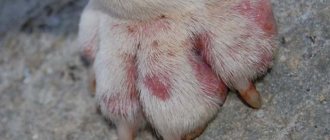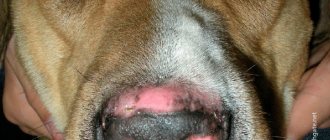Why don't dogs freeze in the cold in winter?
- Of course, the statement that dogs do not freeze in the cold does not apply to each of the many breeds. A lot depends on what kind of hair the dog has: short or long, hard or soft, how thick the undercoat is.
Cold
- So, the thicker, stiffer and longer the wool, the more frost-resistant the breed is and the lower the critical temperatures it can withstand.
- For example, the wool of Caucasians, Moscow watchdogs or Leonbergers , not to mention Huskies, allows them to easily withstand temperatures down to minus 40.
- Moreover, their coat makes positive temperatures not very comfortable for such dogs. But if a representative of such breeds has been raised since puppyhood and kept in conditions that correspond to the characteristics of its coat, then by winter it will grow additional undercoat that warms it.
- In addition, the breeds listed above are large, which do not freeze much longer, since the process of heat transfer takes place more slowly in them.
- Young and healthy dogs tolerate cold temperatures better ; puppies, old or sick dogs with a depleted body, and especially those with arthritis, freeze much faster.
Not all dogs are cold
- The dog’s diet also affects its “frost resistance” - the more caloric and balanced it is, the longer the animal’s body can retain heat.
What should a dog's paws look like?
Let’s note right away that if a dog always has cold paw pads from puppyhood, most likely there is no reason for concern, or you already know about them, just don’t associate them. The structure of the skin on the paws is the same for all canines, but depending on the size and load, it differs in roughness. Large four-legged animals have tenacious, rough, embossed pads, while decorative dogs have very delicate heels even in adulthood.
Normally, the paw temperature is lower than the body, but higher than the environment . Provided that the dog is at rest, the temperature of the limbs is stable. You need to understand that sleep is a state of deep rest, in which the immune system and metabolic processes are very active, which can increase the base body temperature.
Important! If you suspect that your dog's feet are too cold, measure his base body temperature. Fine? If the answer is yes, there is no need to worry too much.
Why don't dogs' paws get cold?
- A dog, unlike a person, easily walks in the snow “barefoot”, and at the same time, its dog’s paws do not freeze in the cold , as our limbs would.
- Why? This question is answered by research by Japanese scientists who talk about the special blood circulation system of dogs. Thus, the arteries located in the paws transfer heat to the veins without returning cold blood back to the dog’s body.
- In fact, there is a process of heat exchange between arterial and venous vessels, which does not allow external losses.
Special circulation
- Thus, the body itself (and the paws in particular) is not subject to cooling, and the close location of the veins causes a faster process of warming the paws. It has been observed that dog paws can withstand temperatures down to -35ºС without frostbite occurring, since the blood supply to the pads does not stop even for a second.
- Similar thermoregulation processes occur in the organisms of those animal species whose habitat is cold latitudes: arctic foxes or penguins, for example.
How to understand that a dog is cold, that a dog is freezing?
Here two options should be considered, since the reaction of a dog accustomed to home conditions will differ from the behavior of an animal accustomed to living in the yard.
How to find out if it's freezing
- For a dog kept in a house or apartment, going outside during the cold season is, of course, more sensitive. The dog will begin to freeze even at slight minuses, or even at low positive temperatures. If the animal begins to shake (moreover, this is more of a large trembling than a small chill), tucks its paws or tail in turn, and whines - it means it is frozen. Such a dog often refuses to go further with the owner for a walk and begins to stubbornly pull the leash towards the house. If your pet literally falls to the ground or onto the snow with its paws breaking , then the dog should definitely be taken to a warm room as quickly as possible to avoid freezing of the animal.
- For those dogs that are kept in enclosures, in kennels , in a word, they live on the street, they need an insulated place that is closed from draft penetration. Otherwise, even a dog that grew up on the street and is well adapted to low temperatures may freeze due to the fact that it will not have the opportunity to dry its snow-soaked fur. The main sign that a yard dog is cold is a large trembling shaking its body. In addition, the dog may tuck its paws.
This is especially clearly manifested in those animals that grew up indoors and were later sent outside - their body, accustomed to warmth, cannot quickly adapt to changes in living conditions.
What is frostbite in dogs?
Frostbite is injury or death of the skin and other tissues caused by exposure to low temperatures.
In dogs, the most susceptible parts of the body to frostbite are the tips of the ears, tail, scrotum and toes. In animals, as in humans, when exposed to low temperatures in the body, blood flow is limited to the extremities and heat is maintained in the center of the body, that is, in the vital organs.
Therefore, if tissue begins to lose blood flow, it quickly becomes cold, freezes, and dies. Frostbite can occur not only when exposed to cold temperatures, but also when an animal is immersed in ice water.
What are the symptoms of frostbite in a dog?
Symptoms of frostbite can appear even within a few days, especially in dogs that are small in weight and size, the main symptoms are:
- Pale areas of skin that turn blue-white or gray from lack of blood flow;
- Skin that is cold to the touch or brittle;
- Ice may form around the affected area;
- Redness, swelling, blisters and ulcers appear;
- With severe frostbite, the skin or limbs turn black, this is called necrosis;
- Over several days and weeks, dead tissue sloughs off;
- There is pus, an unpleasant odor, and signs of a bacterial infection.
- Restoring blood flow in a frostbitten part of the body is accompanied by pain in animals.
Which dogs are susceptible to frostbite?
Almost all animals raised at home and not accustomed to the cold are susceptible to frostbite. Small breed dogs are most vulnerable; and short-haired breeds. If a dog suffers from various heart diseases, diabetes, or is on medication, then it is at risk. Even dogs living outdoors can be susceptible to frostbite if they do not have reliable shelter.
Recommended: Why your dog sleeps a lot and other facts about dog sleep
There are very few dog breeds that can withstand frost without problems.
How do I treat my dog's frostbite?
If there are symptoms of frostbite, the animal must be taken to a veterinarian, who will conduct various tests and prescribe a course of treatment.
First aid for hypothermia is as follows:
- Place the animal in a warm and dry place;
- If the dog has hypothermia, then eliminate this problem, it will be discussed below;
- Do not try to thaw a frostbitten area on your own, if you do not know how to do this, try calling a veterinarian and get advice, or better yet, take him to him right away;
- Gently warm the affected area with water heated to a temperature of about 40 C, check the temperature of the water by placing your hand there, you should feel comfortable, not cold or hot. Use warm compresses or soak the affected area in a bowl of warm water.
- Do not rub the frostbitten area, do not use dry heat (such as a heating pad or hair dryer) and do not use painkillers that can be toxic to your dog, take him to the veterinarian and he will tell you what to do.
Will my dog recover from frostbite?
If frostbite is not severe, then perhaps everything will work out or there will be minor damage to a part of the body; in more serious cases, frostbite can lead to surgery and amputation of the damaged part of the body.
The dog is freezing outside: what to do?
- The smaller the dog, the sooner it freezes. Therefore, decorative dogs, especially short-haired ones, should be dressed in special overalls , and, if possible, shoes or boots . The time of their walks should not be long - it is enough for the pet to do all its big and small things.
- Large and medium-sized dogs classified as short-haired (boxers, bulldogs, Dobermans) also need clothing because they do not have an undercoat to keep them warm. Such dogs should also not be walked for a long time in the cold - 20 minutes is enough.
in winter
- And even long-haired dogs with a thick undercoat, such as Laikas or Caucasians, can freeze if their movements are limited. If you notice that the dog has begun to tremble and, tucking its paws, pulls you towards the house, then it really is time for it to go home.
- To prevent your dog's paws from freezing in the cold, buy special shoes - the choice in veterinary pharmacies and stores is quite wide, from boots to felt boots. If for some reason you cannot do this, do not forget to treat the pads before the walk, using Vaseline or any greasy cream. Such protection will work not only from the cold, but also from mixtures saturated with reagents that are used to sprinkle streets.
- You should especially carefully follow all of the above recommendations if you are taking a puppy for a walk or, conversely, an old dog, a bitch that is expecting or nursing offspring .
At what temperature does a dog freeze?
This is influenced by many factors. The freezing threshold is related to the general health of the dog - if he is sick, he will freeze even at a temperature that he could previously withstand.
- It is important how thick its coat is and how thick the undercoat is - long-haired animals can easily tolerate 20-25 degree frost. A short-haired dog without special clothing will not withstand such temperatures: its “ceiling” is 5°C.
What does it depend on?
- You should not take your dog outside hungry - in this case, the dog will freeze faster even at his usual temperature. And, of course, the external environment in which the animal grew up is important.
- A dog accustomed to room temperatures may begin to tremble even when the thermometer reaches zero, but one raised in outdoor conditions can easily endure much greater frosts.
- An example is stray dogs living in the northern regions: they, curling up in the holes they dug, endure frosts down to -50°C.
Deep hypothermia
In some cases, there may be deep hypothermia, which is characterized by the following symptoms:
- lethargy;
- lethargy;
- temperature drop below 36 degrees;
- rare and shallow breathing;
- slow heartbeat;
- weak pulse.
Sometimes there may even be loss of consciousness. It is very important to immediately help the animal.
The cat loves his new scratching post-bed: we make it in a very simple way
New cartoon “Ogonyok-Ognivo”: starring Natalya Tereshkova and Pyotr Kovrizhnykh
WHO: the second year of the coronavirus pandemic may be more difficult
How to insulate the kennel so that the dog does not freeze?
- Experienced dog breeders under no circumstances recommend placing old clothes or rags . They tend to get wet and damp, and thus the dog is forced to be in a damp atmosphere, which increases the feeling of cold.
- Many people recommend laying hay in which it is convenient for the dog to bury itself, keeping it warm. In addition, hay can absorb small amounts of moisture, which also helps retain heat. Wood shavings or sawdust will also retain heat well.
- Particularly caring owners even supply electricity using a low-power incandescent lamp, covered with an iron bowl attached to the wall of the booth. When you turn on the lamp, the bowl begins to heat up, and the dog can also gain additional warmth by cuddling up to it.
The main thing is to hide the wires well to prevent their contact with the animal, and position the lamp with the bowl in such a way that the dog can move away from it if the bowl gets too hot.
Memo
- Some people use old outerwear to insulate the bed: a coat, a quilted jacket, a sheepskin coat.
- It is better not to place the kennel directly on the ground so that it does not freeze and the bottom does not become damp; it is better to make a wooden flooring on which to place the dog’s housing. The walls can be insulated using penoplex from the outside, and the internal surfaces can be sheathed with felt material .
- It is advisable to cover the entrance to the booth with felt or canvas to protect the animal from drafts.
Useful articles about dogs:
- How to give a pill to a dog?
- Gou dog food
- Allowances of dry dog food per day by weight
- If a dog bites a person, what threatens the owner?
- Which dogs don't shed or smell?











